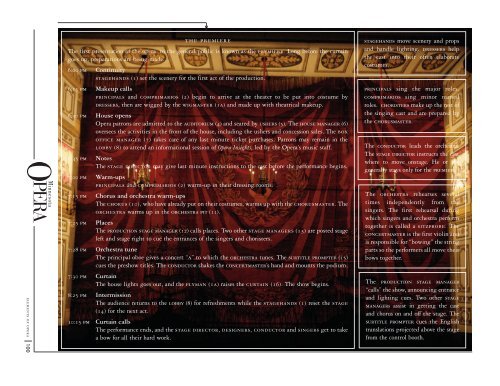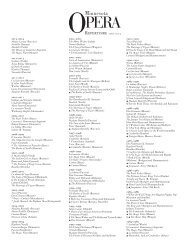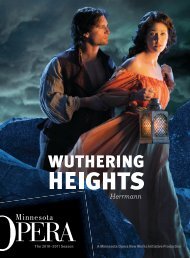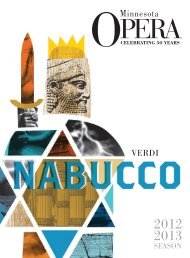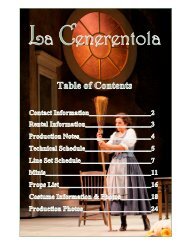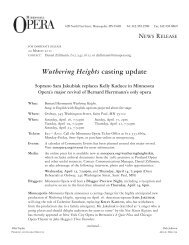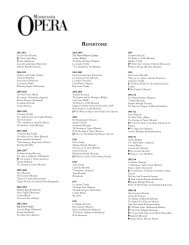You also want an ePaper? Increase the reach of your titles
YUMPU automatically turns print PDFs into web optimized ePapers that Google loves.
elements of opera 100<br />
the premiere<br />
The first presentation of the opera to the general public is known as the premiere. Long before the curtain<br />
goes up, preparations are being made.<br />
6:00 pm Continuity<br />
stagehands (1) set the scenery for the first act of the production.<br />
6:15 pm Makeup calls<br />
principals and comprimarios (2) begin to arrive at the theater to be put into costume by<br />
dressers, then are wigged by the wigmaster (1a) and made up with theatrical makeup.<br />
6:30 pm House opens<br />
<strong>Opera</strong> patrons are admitted to the auditorium (4) and seated by ushers (5). The house manager (6)<br />
oversees the activities in the front of the house, including the ushers and concession sales. The box<br />
office manager (7) takes care of any last minute ticket purchases. Patrons may remain in the<br />
lobby (8) to attend an informational session of <strong>Opera</strong> Insights, led by the <strong>Opera</strong>’s music staff.<br />
6:45 pm Notes<br />
The stage director may give last minute instructions to the cast before the performance begins.<br />
7:00 pm Warm-ups<br />
principals and comprimarios (2) warm-up in their dressing rooms.<br />
7:15 pm Chorus and orchestra warm-ups<br />
The chorus (10), who have already put on their costumes, warms up with the chorusmaster. The<br />
orchestra warms up in the orchestra pit (11).<br />
7:25 pm Places<br />
The production stage manager (12) calls places. Two other stage managers (13) are posted stage<br />
left and stage right to cue the entrances of the singers and choristers.<br />
7:28 pm Orchestra tune<br />
The principal oboe gives a concert “a” to which the orchestra tunes. The surtitle prompter (15)<br />
cues the preshow titles. The conductor shakes the concertmaster’s hand and mounts the podium.<br />
7:30 pm Curtain<br />
The house lights goes out, and the flyman (1a) raises the curtain (16). The show begins.<br />
8:25 pm Intermission<br />
The audience returns to the lobby (8) for refreshments while the stagehands (1) reset the stage<br />
(14) for the next act.<br />
10:15 pm Curtain calls<br />
The performance ends, and the stage director, designers, conductor and singers get to take<br />
a bow for all their hard work.<br />
stagehands move scenery and props<br />
and handle lighting. dressers help<br />
the cast into their often elaborate<br />
costumes.<br />
principals sing the major roles.<br />
comprimarios sing minor named<br />
roles. choristers make up the rest of<br />
the singing cast and are prepared by<br />
the chorusmaster.<br />
The conductor leads the orchestra.<br />
The stage director instructs the cast<br />
where to move onstage. He or she<br />
generally stays only for the premiere.<br />
The orchestra rehearses several<br />
times independently from the<br />
singers. The first rehearsal during<br />
which singers and orchestra perform<br />
together is called a sitzprobe. The<br />
concertmaster is the first violin and<br />
is responsible for “bowing” the string<br />
parts so the performers all move their<br />
bows together.<br />
The production stage manager<br />
“calls” the show, announcing entrance<br />
and lighting cues. Two other stage<br />
managers assist in getting the cast<br />
and chorus on and off the stage. The<br />
surtitle prompter cues the English<br />
translations projected above the stage<br />
from the control booth.


